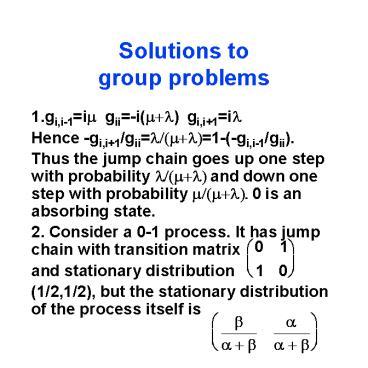Solutions to group problems - PowerPoint PPT Presentation
1 / 18
Title:
Solutions to group problems
Description:
Thus the jump chain goes up one step with probability anddown one step with ... i.e., a multinomial distribution. Some facts about. Poisson point patterns ... – PowerPoint PPT presentation
Number of Views:26
Avg rating:3.0/5.0
Title: Solutions to group problems
1
Solutions to group problems
- gi,i-1i? gii-i(???) gi,i1i?
- Hence -gi,i1/gii???????1-(-gi,i-1/gii).
- Thus the jump chain goes up one step with
probability ????????and down one step with
probability ?????????0 is an absorbing state. - 2. Consider a 0-1 process. It has jump chain with
transition matrix - and stationary distribution
- (1/2,1/2), but the stationary distribution of the
process itself is
2
- 3. This is a birth and death process with ?nl
and ?nm. We know the stationary distribution is
3
Poisson process
- Birth process with rate independent of the state
- Infinitesimal generator
- Time between events?
4
Poisson process, cont.
5
- Siméon Denis Poisson (1781-1840)
- Rudolf Julius Emanuel Clausius (1822-1888)
- Ladislaus Josephowitsch Bortkiewicz (1868-1931)
6
Independent increments
- XPo(?), YPo(?) independent, what is the
distribution of XY? - Write X(t,tsX(ts)-X(t)
- independent of j.
- So events in (0,t is independent of
events in (t,ts, Xt has independent increments
7
Counting process
- N(A) points in A
- If A (s,t then N(A)X(t)-X(s)
- Renyis theorem(s)
- N is the counting process corresponding to a
Poisson process of rate ? iff - P(N(A)0)e-?A for all A
- or
- (ii) N(A) and N(B) are independent for all A
disjoint from B
8
Subsampling
- Suppose we delete points in a Poisson process
independently with probability 1-p. How does that
affect the infinitesimal generator? - Poisson process of rate ?p.
9
Volcanic eruptions
- Recording of volcanic erupotions has gotten more
complete over the last decades
pt
10
- If XtPo(?pt), YtXt/pt is a reconstruction
- Lots of variability in early centuries
11
Nonhomogeneous Poisson process
- XtPo(?(t)) where
- Time change theorem
- Let Yt be a unit rate Poisson process. Then
- Proof Note that ?(t) is monotone. Let s? (t).
Then P(Ysk)ske-s/k! - (?(t))ke-?(t)/k!P(Xtk).
12
General definition
- Consider points in some space S, subset of Rd.
They constitute a Poisson point pattern if - N(A)Po(?(A))
- N(A) is independent of N(B) for disjoint A and B
- ?() is called the mean measure.
- If we call??(s) the intensity function.
13
Spatial case
- Complete spatial randomness
14
Clustering and regularity
- To get a clustered process, start with a Poisson
spatial process, then add new points iid around
the original points - To get a regular process, delete points from a
Poisson process that are closer than d together
15
Real point patterns
- Linhares experimental forest, Brazil
- Control plot
- Clear-cut plot
16
A conditional property
- Let N be a Poisson counting process with
intensity ?(x). Suppose A is a set with ,
N(A)n, and let Q(B)?(B)/?(A) be a cumulative
distribution. It has density ?(x)/?(A) Then the
points in A have the same distribution as n
points drawn independently from the distribution
Q.
17
Proof
- Let A1,...,Ak be a partition of A. Then if
n1...nkn we have - i.e., a multinomial distribution.
18
Some facts about Poisson point patterns
- Superposition The overlay of two independent
Poisson patterns is a Poisson pattern with mean
function the sum of the mean functions - Coloring Consider a Poisson pattern with
intensity ?(x) in which point independently is
colored either green (with probability ?(x)) or
purple (with probability 1-?(x)). Then the green
points form a Poisson process with intensity
?(x)?(x), and the purple points an independent
one with intensity - ?(x)(1-?(x))































